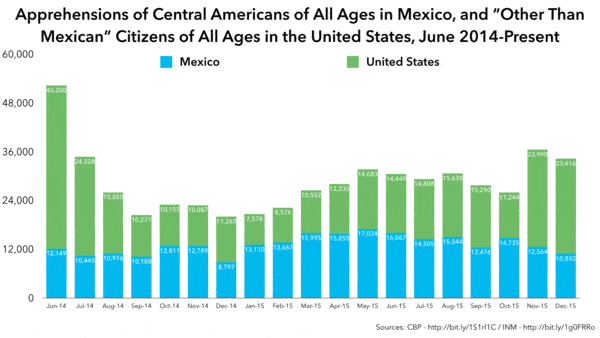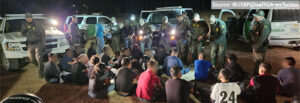Washington, D.C.—When he travels through Mexico from February 12-17, Pope Francis will address the humanitarian crisis of migration, first in the country’s south, and then at Mexico’s northern border. His visit includes cities and states that are common way stations for many of the tens of thousands of unaccompanied migrant children, families, and individuals fleeing violence in Central America’s Northern Triangle.
Experts from the Washington Office on Latin America (WOLA), a leading research and advocacy organization, have been analyzing the situation of migrants in transit through Mexico and documenting the impact of border enforcement along Mexico’s northern and southern borders for more than four years.
Today, WOLA is publishing an interactive map of Mexico’s southern border zone, an area that has become the site of a major U.S.-backed migration crackdown, raising serious humanitarian concerns. Laying out border crossings, train stops, new migrant routes, dangerous areas, security-force presences, and more, the map visualizes what is really happening along Mexico’s southern border.
This interactive map is accompanied by WOLA’s November 2015 report Increased Enforcement at Mexico’s Southern Border: An Update on Security, Migration, and U.S. Assistance. The report finds that since Mexico announced its “Southern Border Plan,” apprehensions of Central Americans in the country have increased 71 percent. Despite the dramatic spike in apprehensions and deportations, Mexico has not increased its capacity to screen migrants for protection concerns, leading many who could qualify for refugee status to be deported back to dangerous situations in their home countries. In addition, far from deterring migrants from traveling north, the crackdown—made possible in part by increased yet un-transparent U.S. funds—has caused migrants to take new and more dangerous routes.
Despite Mexico’s ramped-up enforcement efforts, U.S. authorities continue to encounter high numbers of unaccompanied children and families from Central America, suggesting that migrants and their smugglers have adapted to the crackdown, and will continue to flee their home countries as long as dire conditions persist. In the long term, migration flows will only slow as Central American countries, assisted by the U.S. and other donors, improve both security and opportunity for their citizens. Meanwhile, as Secretary of Homeland Security Jeh Johnson stated last week, many of these Central Americans fleeing violence may qualify for refugee status. The United States must respond appropriately and humanely to all migrants and potential refugees in order to ensure they are not being deported back to life-threatening situations.
As President Obama sends his fiscal year 2017 budget request to Congress this week, it is critical that U.S. assistance to the region urgently address the root causes of migration from Central America’s Northern Triangle—rampant violence, widespread poverty and inequality, corruption, and lack of opportunity—rather than focusing on further buildup at either the U.S. or Mexican southern border. Additional U.S. assistance to Mexico must go beyond a border management focus and invest more at the southern border in strengthening Mexico’s public security, migration, and judicial institutions and enhanced accountability mechanisms for their agents.
For additional resources from WOLA’s Migration and Border Security program, please refer to the following:
- Migration Through Mexico: A Humanitarian Emergency (interactive map of Mexico’s southern border zone)
- Increased Enforcement at Mexico’s Southern Border: An Update on Security, Migration, and U.S. Assistance
- Five Facts about Migration from Central America’s Northern Triangle
- An Uncertain Path: Justice for Crimes and Human Rights Violations against Migrants and Refugees in Mexico
- On the Front Lines: Border Security, Migration, and Humanitarian Concerns in South Texas
###
Contact:
Kristel Mucino
WOLA Director of Communications
+1 (202) 797-2171
press@wola.org


